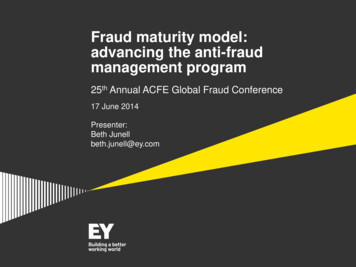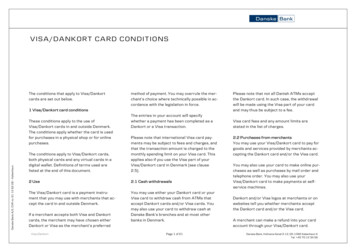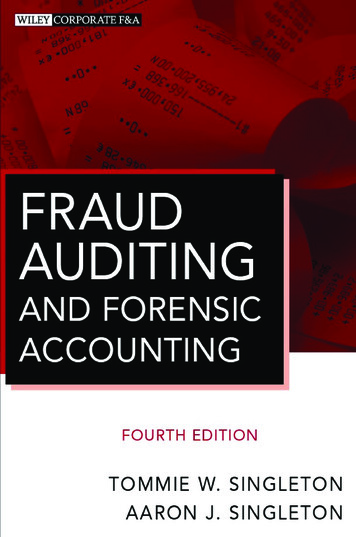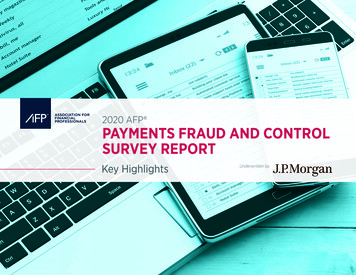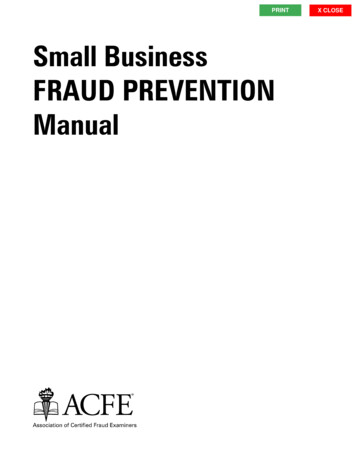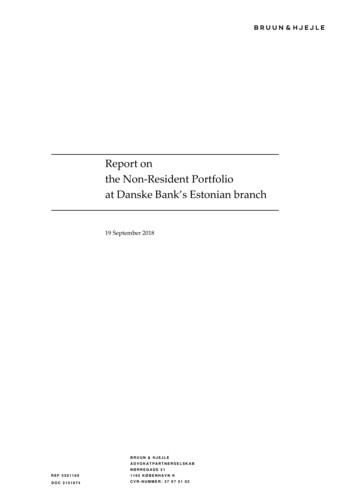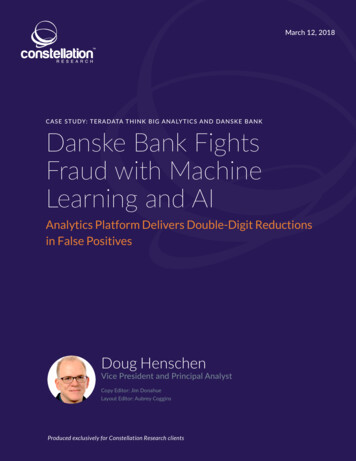
Transcription
March 12, 2018CASE STUDY: TERADATA THINK BIG ANALYTICS AND DANSKE BANKDanske Bank FightsFraud with MachineLearning and AIAnalytics Platform Delivers Double-Digit Reductionsin False PositivesDoug HenschenVice President and Principal AnalystCopy Editor: Jim DonahueLayout Editor: Aubrey CogginsProduced exclusively for Constellation Research clients
TA BLE OF CONTENTSAT A G L A N CE . . . . . . . . . . . . . . . . . . . . . . . . . . . . . . . . . . . . . . . . . . . . . . . . . . . . . . 3THE COMPA N Y . . . . . . . . . . . . . . . . . . . . . . . . . . . . . . . . . . . . . . . . . . . . . . . . . . . . . 4THE CH ALLENG E S. . . . . . . . . . . . . . . . . . . . . . . . . . . . . . . . . . . . . . . . . . . . . . . . . . . 5THE SOLUTI ON. . . . . . . . . . . . . . . . . . . . . . . . . . . . . . . . . . . . . . . . . . . . . . . . . . . . . 6THE IMPAC T . . . . . . . . . . . . . . . . . . . . . . . . . . . . . . . . . . . . . . . . . . . . . . . . . . . . . . 10THE TA K E AWAYS . . . . . . . . . . . . . . . . . . . . . . . . . . . . . . . . . . . . . . . . . . . . . . . . . . 13THE RECOMMENDATI ONS . . . . . . . . . . . . . . . . . . . . . . . . . . . . . . . . . . . . . . . . . . . 14A N ALYS T B I O . . . . . . . . . . . . . . . . . . . . . . . . . . . . . . . . . . . . . . . . . . . . . . . . . . . . . 17A BOUT CON S TELL ATI ON RE S E ARCH. . . . . . . . . . . . . . . . . . . . . . . . . . . . . . . . . . . 18 2018 Constellation Research, Inc. All rights reserved.2
Danske BankAT A G L ANCEDanske Bank is a Nordic financial services companythat operates in 16 countries, serving more than 1,800corporations and institutions, 236,000 small and midsizedcompanies and 2.7 million personal customers. Startingin 2016, the bank saw an increase in fraud and, withthat, an increase in transactions flagged as potentially·· Headquarters: Copenhagen,Denmark·· 2016 Revenue: 8 billion (47.96billion Danish krone)·· No. of Employees: 19,700·· Industry: Financial institutionserving personal, business andcorporate customers with banking,wealth management, life insurance,mortgage, real estate and leasingservices·· Other: Founded October 1871fraudulent by the bank’s rules engine. To reduce numberof false positives—meaning legitimate payments flaggedfor verification—Danske Bank decided to enhance fraudprevention by applying machine learning (ML). The bankBusiness Themesis also investigating applying deep learning (DL) to theData to Decisionsproblem. Executives wished to avoid commercial productsTechnology Optimizationand a siloed approach. Their vision was to use open-sourcetechnology and to gain expertise that could be applied inmany use cases.At a GlanceProblems·· Starting in 2016, Danske Bank saw increases in fraud accompanied by increases in false positives, meaning legitimate paymentswere flagged for verification.·· False positives increased the burden on Danske Bank’s fraud team and potentially delayed legitimate transactions.Solutions·· The bank sought ML and DL expertise that could address fraud and other business challenges.·· Teradata Think Big Analytics offered experience building enterprise-grade ML and DL systems offering human-explainableresults.Benefits·· ML-based models now in use reduce false positives 20 percent to 30 percent.·· DL-based models now in R&D look promising, demonstrating double-digit improvements in fraud detection and furtherreductions in false positives in a test environment. 2018 Constellation Research, Inc. All rights reserved.3
Danske Bank was successful with ML proof-of-THE COMPANYconcept projects, but it lacked experience inbringing these technologies into production.Danske Bank is a 146-year-old financialThe bank turned to Teradata Think Biginstitution that provides banking, wealthAnalytics, the big data strategy, consulting andmanagement, life insurance, mortgage, realimplementation unit of Teradata, which offeredestate and leasing services to personal,expertise and experience with similar high-business, corporate and institutionalscale deployments at major financial servicescustomers. It operates in the Nordic region, thecompanies and other organizations.Baltic states and Ireland, and has offices in 16countries throughout Europe and extending toWorking with Think Big Analytics consultantsRussia, North America and India.in 12-week development and operations(DevOps) sprints, Danske Bank’s teamThroughout its history, Danske Bank hasdeveloped and deployed ML ensemble modelsembraced cutting-edge technology to deliverthat reduced false positives by 20 percent tobetter, more-efficient customer service. In30 percent. DL models developed by the team1997, for instance, it introduced electronicalso look promising. Based on TensorFlow,banking for personal customers. In 1999 itthese DL models have yet to be put intoadded mobile e-banking through cellphones.production, but they’re demonstratingIn 2010 the bank added e-banking throughdouble-digit improvements in fraud detectionsmartphone apps, and in 2013 it introducedand further reductions in false positives in aMobilePay on smartphones.test environment.Danske Bank has embraced advanced, digitaltechnologies internally to increase efficiencyof streamline operations, thereby improvingcustomer service. In recent years, the bankhas developed what it calls the Danske Bank 2018 Constellation Research, Inc. All rights reserved.4
Blueprint for Digitization, which providesTHE CHALLENG E Sreference architectures and sets forthexplicit standards, instructions and approvedThe volume of online and mobile paymentstool sets for building information technologyprocessed by Danske Bank is significant, asassets and components such as applicationthis is the predominant form of paymentprogramming interfaces.in Europe—in contrast to the U.S., wherechecks and remittances still dominate.A key objective at Danske Bank is to be dataThe key challenge that Danske Bank faceddriven, according to Nadeem Gulzar, Danskewas increasingly frequent and increasinglyBank’s head of global analytics. To that end,sophisticated fraud. By 2016, incidents ofGulzar’s team has extended the Danskefraud were on the rise, and with that increaseBank Blueprint to analytics, developingthe bank experienced more false positives,a virtualized, private-cloud edge-servermeaning transactions flagged for verificationconfiguration that offers high-scale Hadoopthat turned out to be legitimate. As theand Spark capacity together with proven andvolume of flagged transactions mounted,hardened analytical tools.Danske Bank started investigating ML as atechnology that could supplement and boost“If a business unit wants to do high-scalethe performance of its incumbent, rules-basedanalytics, they can order the required servicesfraud-detection system.through our internal web shop and they will getan edge server configured with the required“Fraudsters constantly change their modusresources within 15 minutes,” Gulzar explains.operandi, and we constantly need to be betterat detecting potential fraud,” says Gulzar. “Atthe same, we want to reduce the need formanual verification by reducing the numberof false positives, so we can respond as fast aspossible when we detect fraud.” 2018 Constellation Research, Inc. All rights reserved.5
From a business perspective, the bank wanted“We didn’t want to go with a commercial, off-to avoid fraudulent transactions slippingthe-shelf solution from a major vendor becausethrough and too many legitimate transactionswhat we would get would be a point solution,”being flagged for manual validation.says Gulzar. “Our mission was to not only solveFraudulent transactions that slip throughthe fraud situation and the false positives, butmean financial losses for the customers andat the same time to build generic componentsthe bank. False positives degrade customerand capabilities that could be used for manyexperience both by slowing overall processingother use cases. The only way we saw thattimes and by requiring unnecessary customercould happen was if we built it ourselves.”interactions to verify the authenticity ofpayments requests.Gulzar’s team completed proof-of-concepttests using ML in the summer of 2016, andTHE SOLUTIONearly tests showed that the approach increaseddetection of fraud and reduced false positivesPayments aren’t the only area where fraudwith a performance edge on both countscrops up at Danske Bank or, indeed, at anyof 20 percent to 25 percent over the rulesbank. Credit card transaction processingengine. These early results confirmed thatand anti-money-laundering are two otherDanske Bank was on the right track, but Gulzarareas that Danske Bank had in mind whensays the company knew it would need helpconsidering a solution to the problem in thedeploying models in a production environmentpayment area. Gulzar and his team weredemanding 300-millisecond response times.interested in an open-source technologyAt the conclusion of a vendor review processsolution that could be applied to many areasconducted during the summer of 2016, Danskeof the business, and they were specificallyBank signed a contract with Teradata Think Bigconsidering ML and DL.Analytics in September of that year. 2018 Constellation Research, Inc. All rights reserved.6
“We considered many vendors, including both softwarecompanies and consultancies, but the main issue withsome of the other players was that they relied at leastpartially on commercial products,” says Gulzar. “Weturned to Think Big because they had handled this exactuse case at a different bank. We also had talks with themabout our thoughts about architecture, and they confirmed“Our mission was to notonly solve the fraudsituation but to buildgeneric componentsand capabilities thatcould be used for manyother use cases.”that they could work with open-source tools and deliver to– Nadeem Gulzar,Danske Bank, Head ofGlobal Analyticsour requirements.”Founded in 2010 and focused on data engineering and datascience consulting and support, Think Big Analytics hasworked with top-10 banks, major insurers and retailers, taxauthorities and health care organizations. The companywas acquired by Teradata in 2014. Danske Bank was nota Teradata customer at the time of the engagement. Itlearned of the consulting services from Think Big Analyticsby hearing about prior engagements with banks.The Technologies·· Data management platformsinclude the Hortonworks Hadoop/Spark distribution and Cassandra.Incumbent assets include an IBMmainframe and a Microsoft SQLServer data warehouse.·· Data analysis and modeldevelopment tech includes Hive,Spark, Python/PySpark on Anacondaand TensorFlow running on NvidiaThink Big Analytics works with both open-sourcetechnologies and commercial, off-the-shelf products,according to Atif Kureishy, VP of global emerging practices.That choice depends on the client’s preferences. Regardlessof the technology choices, the consultancy firm’s focus ison its “Analytic Ops” methodology. Kureishy describes it asGPU clusters.·· Development and deployment management tools include Jenkins, JIRAand Atlassian Bitbucket.·· Model visibility is supported by theopen-source LIME (Locally Interpretable Model-agnostic Explanations)framework, which ensured compliance with EU GDPR requirements.a holistic, DevOps-style approach to analytics with a focuson repeatability and automation. 2018 Constellation Research, Inc. All rights reserved.7
“What’s important is not necessarily the toolsof meeting the data pipeline performancebut the methodologies and approaches thatrequirements. By mid-February 2017 the firsttie everything together,” says Kureishy, one ofround-trip test transactions were executed.lead consultants at Think Big Analytics on theDanske Bank project. “How do you deploy theAs shown in Figure 1, the new Advancedmodels and handle inferencing and A/B testingAnalytics Platform for Fraud that the teamand the entire project lifecycle, includingdeveloped was designed to work alongsidetraining? That’s what we call Analytic Ops, andthe existing rules engine (a point we’ll returnit’s what we worked closely with Danske Bankto in “The Takeaways” section on page 13).on mastering.”The deployment also created a closed-loopsystem in which ML and DL models couldThe Deploymentquickly learn from the outcomes of manualfraud investigations through updated fraudThe project got underway in October 2016.data. One of the key challenges was ensuringAt its peak, the team included a diverse,adequate performance.interdisciplinary group of 40 people. Thatincluded more than 30 platform engineers,“We had to ensure a total response time ofnetwork engineers, data engineers, datano more than 300 milliseconds, from thescientists, payment and fraud experts, fraudmainframe transaction to data-enrichment toinvestigators, and hardware and infrastructurescoring and on to the response, but that meantexperts from Danske Bank and six to sevenwe had to handle the model scoring within 100consultants from Think Big Analytics. The teammilliseconds,” says Kureishy.worked together in 12-week sprints pursuingtwo tracks: data science and data engineering.Once performance was proven, the AdvancedAnalytics Platform for Fraud was run in parallelBy late January 2017 the team delivered thewith the incumbent rules engine from Marchfirst production virtual machines capableuntil June. It was a period of testing, learning 2018 Constellation Research, Inc. All rights reserved.8
Figure 1. Danske Bank’s New Advanced Analytics Platform for Fraud, Top Right,Complemented the Existing Fraud EngineSource: Danske Bankand optimization using live transactionalModel scores, in contrast, may be based ondata, but the results of the models weremany data features and interactions amongnot yet put back into production. Engineersthose features. Think Big Analytics andwere production-hardening the newDanske Bank have chosen the LIME (Locallyplatform, including aspects of security andInterpretable Model-agnostic Explanations)high availability.framework to help system users understandand explain how scores are determined.Rules tend to be simple and human readable,as in this example: “if [amount] is larger thanLIME helps explain the classifiers applied to[X], queue transaction to manual verification.”flagged transactions as well as what features 2018 Constellation Research, Inc. All rights reserved.9
of the data contributed to the prediction. Itunit (GPU) servers. As discussed in the nextmight be that compared to the customer’ssection, these models have delivered evenusual or recent behavior, if the location ofmore promising performance than the MLthe transaction was significantly different. Ifmodels in spotting fraud and reducing falseone moment transactions are coming in frompositives. For now, the DL research isDenmark and suddenly they’re happening inon hold while Danske Bank focuses onChina, or there is some other significant changesupporting many more transaction types onin behavior, then the transactions showing athe ML-based models.change in behavior are likely to be flagged formanual verification.THE IMPAC TIn mid-June 2017, Danske Bank broughtDanske Bank was encouraged enough by thethe first wave of ensemble, ML models into20 percent to 25 percent improvement inproduction, having been satisfied on twoperformance it experienced in its proof-of-fronts: that the new platform was readyconcept tests, but it was even more pleasedfor production performance and reliabilitywith the performance of ML-based modelsand that the models were thoroughly trainedput into production in June 2017. With helpand optimized.from Think Big Analytics, the team developedensemble models combining boosted decisionThe performance results of the ML modelstrees and regression. After training andare discussed below in the next section, butoptimization, these models reduced falsethis was just the first phase of the plannedpositives by 20 percent to 30 percent.deployment. Following the ML modeldeployment, the team started work onDanske Bank declined to divulge the costDL-based modeling using the open-sourceof the project or any monetary values tiedTensorFlow framework running on high-to its benefits, but it did detail benefits onperformance Nvidia graphical processingfour fronts: 2018 Constellation Research, Inc. All rights reserved.10
1. Increased efficiency in fraud investigations.running on two Nvidia GPU-based clusters.Danske Bank experienced an immediate 20Experiments with three DL methods—percent to 30 percent reduction in fraudconvolutional neural networks (CNN),false positives, with further reductionslong short-term memory (LSTM) and auto-anticipated based on DL-based models.encoders—soon delivered double-digitreductions in false positives and further2. Faster response times. The platform scorestransactions and provides actionable insightimprovements in the identification offraudulent transactions.within 300 milliseconds. The deploymenthas solved the first use case, fraud detection,Because it is based on neural nets that mimicbut it’s designed to support further solutionsthe brain and that are capable of self-learning,for Danske Bank business units.DL is often described as a form of artificialintelligence (AI). At this writing, the production3. Improved customer experience. Betweendeployment of DL models is on hold whilefaster performance and reductions in falseDanske Bank works on identifying many otherpositives, customers are experiencingtypes of fraudulent transactions using ML.improved customer service with fewerThough not yet planned, next steps towardunnecessary delays in payments and fewerputting DL models into production wouldunnecessary payment-verification contacts.include integrating the Nvidia GPU-basedclusters into a low-latency production dataThe Promise of Deep Learningpipeline and tuning and optimizing the DLbased models for 100-millisecondAfter developing the Advanced Analyticsscoring performance.Platform with ML-based models in June2017, the team moved on to develop DL-It’s not a question of if but when Danske Bankbased models using TensorFlow algorithmswill need to draw on these more-advanced 2018 Constellation Research, Inc. All rights reserved.11
DL capabilities. “With machine learning we’veacross many features in data. “This is whereachieved very good results, but it’s capped at adeep learning will come into the picture, andcertain level,” says Gulzar.the early results have been really impressive,”Gulzar says.Where ML models look at transactionsatomically, for example, DL methods areAs stated in Danske Bank’s winning entry (Seebetter able to spot patterns across a seriesFigure 2) in the Data to Decisions category ofof transactions and to capture correlationsthe Constellation Research 2017 SuperNovaFigure 2. Danske Bank ML & DL Model Test ResultsA performance graph comparing random predictions (black dotted line), Danske Bank’s rules engine(red dot), ML-based models now in production (blue), and DL test results, including a CNN model(orange), a residual CNN model (green) and an LSTM model (red).Source: Danske Bank 2018 Constellation Research, Inc. All rights reserved.12
Awards, “Danske Bank recognizes the needdesigned to support the fraud detectionto be ready with cutting-edge techniques tounit without disrupting or unnecessarilyengage fraudsters not where they are today,changing existing processes. The approachbut where they will be tomorrow.”adds value to the systems already in placeand supplements the work carried out byTHE TAKE AWAYSfraud analysts and investigators.Both Danske Bank and Think Big Analytics Don’t rely on ML or DL alone. The bank isshared lessons learned and best-practiceseeking to complement, rather than replace,advice that’s valuable for any organizationits rules-based system. “The fraudsterslooking to apply ML and DL techniques toare quite ambitious, and if they learn thatfraud or other challenges.you’re relying on machine learning alonethey can launch a series of [non-fraudulent] Tap a range of subject matter experts.transactions that would act as a precursorDanske Bank made a point of engaging ato an attack,” says Gulzar. “They’re trainingmultidisciplinary team that included notthe models to behave in a certain way sojust platform engineers, network engineers,that when the fraudulent transaction isdata engineers and data scientists buttriggered, the model would let it pass.”also payment experts, fraud experts andBy combining approaches, you reducefraud investigators. The fraud experts andthe chances of fraudulent transactionsinvestigators should not be brought in justslipping through.for training on the new system; they can becrucial contributors to understanding fraudpatterns and related anomalies in data. Embrace open-source technology. DanskeBank favored open-source technologiesover commercial solutions because it sees Don’t rip and replace. Danske Bank’sAdvanced Analytics Platform for Fraud isopen-source communities as a magnet forinvestment and innovation. “If you look 2018 Constellation Research, Inc. All rights reserved.13
at [Apache] Spark, as an example, IBM,customer experience, customer journeys andMicrosoft and many other big players arecustomer satisfaction, and you can begin toputting hundreds of millions of dollarsextend your analytical reach.”into development,” says Gulzar. “That’sobviously going to benefit [Spark] in terms ofTHE RECOMMENDATIONScapabilities and functionality.” Determine your build-versus-buy strategy: Build flexible capabilities that can beThink Big Analytics describes AI and MLapplied to many use cases. Rather thanas something that should be strategic forbuying an off-the-shelf solution designedmost companies. “You have to have skin inexclusively for payment fraud, Danskethe game, which means you need to trainBank wanted to develop infrastructure andmodels with your own data and learn how toskills that could be applied in many frauduse them,” says Ben MacKenzie, director ofscenarios. It’s an approach that Think BigAI engineering at Think Big Analytics. “YouAnalytics wholeheartedly supports.can’t outsource that to vendors that aregoing to give you a packaged solution.”“Once you have the infrastructure andmechanisms in place, you can open up theConstellation’s POV: Constellation expectsaperture to different product lines, such asthat organizations will increasingly facecredit cards, loans, checking accounts, andbuild-versus-buy decisions as ML- andsavings accounts, and to other use cases,AI-based products and services offeringssuch as know-your-customer and anti-money-proliferate and as adoption grows.laundering compliance,” says Kureishy of ThinkNot all aspects of a company can beBig Analytics. “That’s just on the risk, frauddifferentiating, so there will be a place forand compliance side. Next you can start tobuying and building. Long-term, defensibledetermine how these factors are impactingdifferentiation tends to be most closely 2018 Constellation Research, Inc. All rights reserved.14
tied to unique brand promises and the unique customerexperiences that organizations can deliver. Mature from proof-of-concept experimentation torepeatable production execution. Many organizationshave analytics competency centers and do-it-yourselfattitudes, but there’s a big difference between proof-of-“You have to investto get the talent,the infrastructureand access to thedata in place tobuild a corporateintelligence function.”concept projects and hardened production deployments.“Organizations see the power of these techniques, but– Atif Kureishy,Teradata Think Big Analyticsthe reality is that many POCs never see the light of day,”says Kureishy. “You have to make an investment to getthe talent, the infrastructure and access to the data inplace to build a corporate intelligence function.”Constellation’s POV: Many organizations talk a goodgame about being data-driven companies, but industryleaders are forging industrialized and highly automatedapproaches to building models and data pipelines.You have to mature from disparate, uncoordinatedexperimentation to adopt consistent standards andrepeatable methodologies and processes. Build trust with transparency and training. ML- andDL-based systems can’t be black boxes. That’s a matterof regulation in banking, insurance and other industrieswhere certain types of predictive decisions must beexplainable and proven to be unbiased. But customers 2018 Constellation Research, Inc. All rights reserved.15
and employees in any industry will naturallyand train and prepare employees on newmore readily trust decisions that aresystems and processes.transparent and easily explainable.Some types of algorithms are moretransparent than others. Random forestapproaches, for example, are inherentlyinterpretable, whereas the neural netsused in DL are more inscrutable. Think BigAnalytics execs recommended the LIMEframework in the Danske Bank deploymentbecause it was one of the few optionsavailable for model-agnostic interpretabilityat the time. But this is an ongoing areafor cutting-edge AI research, they say.The approach that Think Big Analyticstook for LIME deployment has satisfiedthe requirements of auditors andregulatory officers.Constellation’s POV: Transparency,training and trust go together. Don’t expectcutting-edge ML and DL deployments tosucceed without transparency or training.Whether required by regulation or not,build interpretability into your systems 2018 Constellation Research, Inc. All rights reserved.16
A N ALYS T B I ODoug HenschenVice President and Principal AnalystDoug Henschen is Vice President and Principal Analyst at Constellation Research, Inc., focusing on datadriven decision making. His Data-to-Decisions research examines how organizations employ data analysis toreimagine their business models and gain a deeper understanding of their customers. Data insights also figureinto tech optimization and innovation in human-to-machine and machine-to-machine business processes inmanufacturing, retailing and services industries.Henschen’s research acknowledges the fact that innovative applications of data analysis require a multidisciplinary approach, starting with information and orchestration technologies, continuing through businessintelligence, data visualization, and analytics, and moving into NoSQL and big data analysis, third-party dataenrichment, and decision management technologies. Insight-driven business models and innovations are ofinterest to the entire C-suite.Previously, Henschen led analytics, big data, business intelligence, optimization, and smart applications researchand news coverage at InformationWeek. His experiences include leadership in analytics, business intelligence,database, data warehousing, and decision-support research and analysis for Intelligent Enterprise. Further,Henschen led business process management and enterprise content management research and analysis atTransform magazine. At DM News, he led the coverage of database marketing and digital marketing trendsand news. @DHenschen www.constellationr.com/users/doug-henschen www.linkedin.com/in/doughenschen 2018 Constellation Research, Inc. All rights reserved.17
ABOUT CONS TELL ATION RE S E ARCHConstellation Research is an award-winning, Silicon Valley-based research and advisory firm that helps organizationsnavigate the challenges of digital disruption through business models transformation and the judicious application ofdisruptive technologies. Unlike the legacy analyst firms, Constellation Research is disrupting how research is accessed, whattopics are covered and how clients can partner with a research firm to achieve success. Over 350 clients have joined from anecosystem of buyers, partners, solution providers, C-suite, boards of directors and vendor clients. Our mission is to identify,validate and share insights with our clients.Organizational Highlights·· Named Institute of Industry Analyst Relations (IIAR) New Analyst Firm of the Year in 2011 and #1 Independent Analyst Firm for 2014 and 2015.·· Experienced research team with an average of 25 years of practitioner, management and industry experience.·· Organizers of the Constellation Connected Enterprise—an innovation summit and best practices knowledge-sharing retreat for business leaders.·· Founders of Constellation Executive Network, a membership organization for digital leaders seeking to learn from market leaders and fast followers. www.ConstellationR.com @ConstellationR info@ConstellationR.com sales@ConstellationR.comUnauthorized reproduction or distribution in whole or in part in any form, including photocopying, faxing, image scanning, e-mailing, digitization, or making available for electronicdownloading is prohibited without written permission from Constellation Research, Inc. Prior to photocopying, scanning, and digitizing items for internal or personal use, pleasecontact Constellation Research, Inc. All trade names, trademarks, or registered trademarks are trade names, trademarks, or registered trademarks of their respective owners.Information contained in this publication has been compiled from sources believed to be reliable, but the accuracy of this information is not guaranteed. Constellation Research,Inc. disclaims all warranties and conditions with regard to the content, express or implied, including warranties of merchantability and fitness for a particular purpose, nor assumesany legal liability for the accuracy, completeness, or usefulness of any information contained herein. Any refe
Bank's head of global analytics. To that end, Gulzar's team has extended the Danske Bank Blueprint to analytics, developing a virtualized, private-cloud edge-server configuration that offers high-scale Hadoop and Spark capacity together with proven and hardened analytical tools. "If a business unit wants to do high-scale


